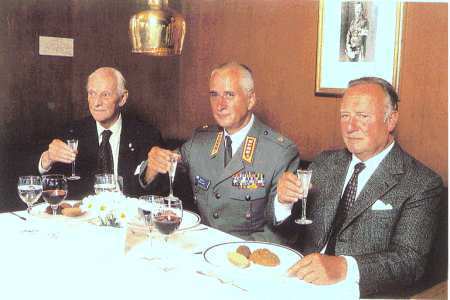


 The
ADC came up with this recipe: one litre of Rajamäki aquavitae, 2 centilitres of dry
French vermouth and 1 centilitre of gin. This drink has been named Marshal’s drink.
The problem nowadays is that the exactly same ingredients as during the war are not
available anymore.
The
ADC came up with this recipe: one litre of Rajamäki aquavitae, 2 centilitres of dry
French vermouth and 1 centilitre of gin. This drink has been named Marshal’s drink.
The problem nowadays is that the exactly same ingredients as during the war are not
available anymore.In the Russian army, a meal included one drink. The glasses were poured chock-full to avoid differences in measuring. Mannerheim adopted the same principle; the glass had to be full and nothing should be dropped when drinking it. This tradition is still connected with the Marshal’s drink.
 When Mannerheim was asked about the background of the tradition
of the chock-full glass, he said it went back to the custom in the Russian army, their
Cavalry School and the Chevalier Guards, in whose ranks Mannerheim had served himself. It
was a custom in St Petersburg at the end of the 19th century that part of the
officers’ salary was paid as drinks: one at breakfast and two at dinner. It was quite
natural that everyone wanted the glass as full as possible, as the state was in charge of
the costs.
When Mannerheim was asked about the background of the tradition
of the chock-full glass, he said it went back to the custom in the Russian army, their
Cavalry School and the Chevalier Guards, in whose ranks Mannerheim had served himself. It
was a custom in St Petersburg at the end of the 19th century that part of the
officers’ salary was paid as drinks: one at breakfast and two at dinner. It was quite
natural that everyone wanted the glass as full as possible, as the state was in charge of
the costs.
In his youth Mannerheim experienced a bitter disappointment in Paris, when the French cuisine and the Russian drinking tradition clashed in a fateful manner. When he was having dinner in the company of Russians and ordering vodka before the meal, his order was declined. The French butler regarded the schnaps as a barbarian custom and sacrilege, which numbs the taste nerves. Despite the emotional outburst the butler did not give in, and the dinner party had to go and drink the schnapses in the bar.
World War II | Pacific War | Winter War | Headquarters | Mannerheim Line | Vilho Petter Nenonen | K.L. Oesch | Harald Öhquist | Paavo Talvela | Continuation War |Transit Pact | Risto Ryti | Order of the Day of the Sword Scabbard | Erik Heinrichs | A.F. Airo | Hugo Österman | Marshal's Drink | Mannerheim Cross | Title of Marshal of Finland | Air War - Air Forces
COURSE OF LIFE | FAMILY | TIME OF GROWTH | MILITARY CAREER | WAR OF INDEPENDENCE | REGENT 1918-1919 | CIVILIAN | DEFENCE COUNCIL | COMMANDER-IN-CHIEF 1939-1946 | PRESIDENT OF THE REPUBLIC 1944-1946 | RETIREMENT | SPECIAL TOPICS | SEARCH